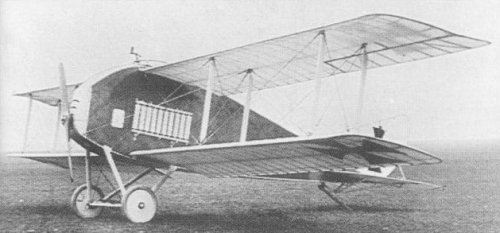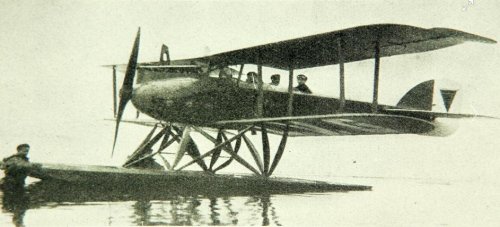You are using an out of date browser. It may not display this or other websites correctly.
You should upgrade or use an alternative browser.
You should upgrade or use an alternative browser.
German WW1 Fighters and Recce Aircraft Prototypes and Projects
Tuizentfloot
ACCESS: Secret
- Joined
- 9 May 2010
- Messages
- 269
- Reaction score
- 144
It was an experimental biplane, designed by Dr. Waldemar Geest, and with the typical "Möwe"-wing of earlier Geest designs.
Tuizentfloot
ACCESS: Secret
- Joined
- 9 May 2010
- Messages
- 269
- Reaction score
- 144
The Germania DB was in fact a bigger two-bay two seater evolved from the single seat JM. Both 1916 and experimental.
- Joined
- 11 March 2006
- Messages
- 8,633
- Reaction score
- 3,489
Tuizentfloot said:The Germania DB was in fact a bigger two-bay two seater evolved from the single seat JM. Both 1916 and experimental.
Indeed, here's the JM (photo from Gray/Thetford "German Aircraft Of The Firts World War"). From what I
found out, only the B from 1915 actually the Typ B was introduced into service and used by some flying
schools in limited numbers.
Attachments
Tuizentfloot
ACCESS: Secret
- Joined
- 9 May 2010
- Messages
- 269
- Reaction score
- 144
Indeed, Jemiba, only the Germania B I was used in limited numbers in 1915 by Germania's military flying school .
Of the other Germania types only of the C IV school machine (1917) more than one was built (Lange), but Gray/Thetford state that only one was built.
There is some confusion about the designation of this type: Nowarra in his Entwicklung ... calls it B II (C 4). Was C IV or C 4 an internal designation?
The main activity of the Germania-Flugzeugwerke was licence building (e.g. Rumpler C I).
Before 1915 germania was called Rathjens & Co. (since 1912).
Of the other Germania types only of the C IV school machine (1917) more than one was built (Lange), but Gray/Thetford state that only one was built.
There is some confusion about the designation of this type: Nowarra in his Entwicklung ... calls it B II (C 4). Was C IV or C 4 an internal designation?
The main activity of the Germania-Flugzeugwerke was licence building (e.g. Rumpler C I).
Before 1915 germania was called Rathjens & Co. (since 1912).
Tuizentfloot
ACCESS: Secret
- Joined
- 9 May 2010
- Messages
- 269
- Reaction score
- 144
Hannover CL V: 46 built
Hannover CLS I: 1 built
Hannover CLS I: 1 built
- Joined
- 26 May 2006
- Messages
- 33,568
- Reaction score
- 13,698
Tuizentfloot said:Hannover CL V: 46 built
Hannover CLS I: 1 built
Thank you Tuizentfloot.
Tuizentfloot
ACCESS: Secret
- Joined
- 9 May 2010
- Messages
- 269
- Reaction score
- 144
All I know is that the W II was another post-war (1919) modified C VI on floats, just like the W I.
- Joined
- 25 July 2007
- Messages
- 4,167
- Reaction score
- 3,834
hesham said:does anyone hear about Kondor W.III and W.IV seaplanes ,and are they a projects ?.
No but there is mention here of Die Flugzeuge der Kondor-Werke by Wolfgang Wagner in Aerokurier 1/74 and 6/74, Gelsenkirchen, 1974. Anyone have access to these articles? http://www.josef-suwelack.de/files/geschichte_der_kondorwerke.pdf
Tuizentfloot
ACCESS: Secret
- Joined
- 9 May 2010
- Messages
- 269
- Reaction score
- 144
Dear Hesham,
About the Kondor types the only information I have is the following:
W III - two-bay biplane, 1 built.
W IV - 1 1/2 strutter, 1 built.
I suppose the W III and W IV were designs by Paul Westphal, as were the W I and W II (hence the W designation). Ni idea of the year when built (WI and W II date from 1914/15).
The designers of the Kondor types were Josef Suvelack (1912-1914), Paul Westphal (1914-1918?) and Walter Rethel (1914-1916 and 1917-1918).
About the LFG W 16: biplane floatplane of 1917/18 with Daimler D III, 1 built (Marine Nr. 943). Nowarra in his Entwicklung ... says the construction was not completed.
About the Kondor types the only information I have is the following:
W III - two-bay biplane, 1 built.
W IV - 1 1/2 strutter, 1 built.
I suppose the W III and W IV were designs by Paul Westphal, as were the W I and W II (hence the W designation). Ni idea of the year when built (WI and W II date from 1914/15).
The designers of the Kondor types were Josef Suvelack (1912-1914), Paul Westphal (1914-1918?) and Walter Rethel (1914-1916 and 1917-1918).
About the LFG W 16: biplane floatplane of 1917/18 with Daimler D III, 1 built (Marine Nr. 943). Nowarra in his Entwicklung ... says the construction was not completed.
Tuizentfloot
ACCESS: Secret
- Joined
- 9 May 2010
- Messages
- 269
- Reaction score
- 144
The NFW E III is unknown to me, but the E I and E II were wooden monoplane fighters. Since the E II was a stronger modification of the E I, maybe the E III was a project of another modification?
Tuizentfloot
ACCESS: Secret
- Joined
- 9 May 2010
- Messages
- 269
- Reaction score
- 144
As far as I know LTG built only two types: a biplane apparently without desination and the FD 1 (also called 5D 1 or SD 1 - the last probably a misprint of 5D 1).
Was it eventually the Ursinus seaplane built by Gotha you asked for? It had retractable floats.
Was it eventually the Ursinus seaplane built by Gotha you asked for? It had retractable floats.
Tuizentfloot
ACCESS: Secret
- Joined
- 9 May 2010
- Messages
- 269
- Reaction score
- 144
Indeed, Hesham, the LVG D 9W (internal designation) was a recce biplane on floats with Daimler (Mercedes) D III. It was a float version of the C III (internal designation D 9). One built (probably the sole C III with floats).
Tuizentfloot
ACCESS: Secret
- Joined
- 9 May 2010
- Messages
- 269
- Reaction score
- 144
Dear Hesham
The early war German A and B-types are a big puzzle. In those days the exact designation of a type or subtype of aircraft apparently didn't matter, and mostly the aircraft were designated simply as a A- or B-type.
Since 1911 the Otto-Flugzeugwerke built a number of different B-types. We can find reference to two of these as B I, but I don't know if this is a posterior designation or not.
I found the following references:
Kroschel & Stützer, Die deutschen Militärflugzeuge 1910-1918 (1994): B I with Rapp R I, 100 hp (max. speed 110 km/h), or with Mercedes (Daimler) D II, 120 hp (max. speed 135 km/h). Both span 14,5 m and enght 7,8 m. Built in 1914.
Lange, Typenhandbuch der deutschen Luftfahrttechnik (1986): Apparently the same planes, also built in 1914, but designated simply as B-types. The one with a Rapp engine (150 hp) was a two bay biplane, and the other (with a D III) was a three bay biplane.
Gray & Thetford, German Aircraft of the First World War (1970): On pages 494 and 495 photographs of an "Otto B 100 hp Rapp 1914" and "Otto B I 1914", two and three bay versions.
A little confusing, isn't it?
The early war German A and B-types are a big puzzle. In those days the exact designation of a type or subtype of aircraft apparently didn't matter, and mostly the aircraft were designated simply as a A- or B-type.
Since 1911 the Otto-Flugzeugwerke built a number of different B-types. We can find reference to two of these as B I, but I don't know if this is a posterior designation or not.
I found the following references:
Kroschel & Stützer, Die deutschen Militärflugzeuge 1910-1918 (1994): B I with Rapp R I, 100 hp (max. speed 110 km/h), or with Mercedes (Daimler) D II, 120 hp (max. speed 135 km/h). Both span 14,5 m and enght 7,8 m. Built in 1914.
Lange, Typenhandbuch der deutschen Luftfahrttechnik (1986): Apparently the same planes, also built in 1914, but designated simply as B-types. The one with a Rapp engine (150 hp) was a two bay biplane, and the other (with a D III) was a three bay biplane.
Gray & Thetford, German Aircraft of the First World War (1970): On pages 494 and 495 photographs of an "Otto B 100 hp Rapp 1914" and "Otto B I 1914", two and three bay versions.
A little confusing, isn't it?
Tuizentfloot
ACCESS: Secret
- Joined
- 9 May 2010
- Messages
- 269
- Reaction score
- 144
hesham said:Hi,
the LTG developed a float biplane with retractable floats in 1917,does anyone know it ?.
Dear hesham, the LTG with retractable floats puzzled me ever since you asked this.
Now, I found in Pawlas, Deutsche Flugzeuge 1914-1918 (1976), pp. 259-260, four photographs of an "LTG Kampfflugzeug mit einziehbaren Schwimmern". And it is nothing less than the well-known Ursinus floatplane Marine Nr. 782… Was it built by LTG?
Lange in his Typenhandbuch says the Ursinus Nr. 782 was built by Flugmachine Rex GmbH, and calls it the "Rex-Einsitzer mit hochziehbaren Schwimmern". The Ursinus built by Rex?
And Herris in his recent Gotha Aircraft of WWI says the Ursinus Nr. 782 was built by Gotha, and gives it the Gotha designation WD 10. So, a possible third constructor of the Ursinus…
Where was this plane with retractable floats really built? By LTG, by Rex, or by Gotha?
Similar threads
-
-
Experimental ww1 fighters from Albatros and Siemens
- Started by T-50
- Replies: 12
-
Friedrichshafen Little Known Prototypes & Projects
- Started by hesham
- Replies: 16
-
LFG (Luft-Fahrzeug-Gesellschaft) Projects
- Started by hesham
- Replies: 21
-





